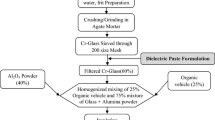Abstract
The paper presents investigation of four lead free thick film resistor pastes, developed at ITME, denoted R-100, R-1k, R-10k and R-100k with sheet resistivities of 0.1, 1, 10 and 100 kΩ/□, respectively. The resistors were based on RuO2 as the conductive phase. The aim of the work was to evaluate the influence of firing conditions of the resistive pastes on a sintering process. The pastes were screen printed onto alumina substrate with prefired AgPd lead-free terminations. They were fired at several temperatures from 750 to 950 °C for 10 min at peak temperature, as well as fired at the highest temperature for 6 h, in order to bring the sintering process into the equilibrium. The properties of the resistors, i.e , sheet resistivity and temperature coefficient of resistance (TCR), microstructure changes, glass crystallization upon firing, etc., were examined. Dried and fired resistor samples were evaluated by X-Ray diffraction analysis and by the scanning electron microscopy. The RuO2 conductive phase maintained the same crystal structure regardless of the firing conditions. No devitrification was observed in lead-free resistors glasses. The lattice constants of RuO2 were uniform after firing at temperatures over 800 °C. The resistors matched the desired resistivity and the TCR was the least temperature dependent at the firing temperatures around 850 °C.










Similar content being viewed by others
References
B. Morten, G. Ruffi, F. Sirotti, A. Tombesi, L. Moro1, T. Akomolafe, Lead-free ruthenium-based thick-film resistors: a study of model systems, J. Mater. Sci. Mater. Electron. Vol. 2, No. 1, March 1991, pp. 46–53
K. Adachi, H. Kuno, Decomposition of ruthenium oxides in lead borosilicate glass. J. Am. Ceram. Soc. Vol. 80, No. 5, May 1997, 1055–1064
M. Hrovat, T. Maeder, J. Holc, D. Belavič, J. Cilenšek, J. Bernard, Subsolidus phase equilibria in the RuO2–Bi2O3–SiO2 system. J. Eur. Ceram. Soc. 28(11), 2221–2224 (2008)
M. Hrovat, J. Holc, D. Belavič, J. Bernard, Subsolidus phase equilibria in the PbO-poor part of RuO2–PbO–SiO2 system. Mater. Lett. Vol. 60, No. 20, September 2006, 2501–2503
S. Rane, M. Prudenziati, B. Morten, CaRuO3-based ‘Green’ thick film resistors. J. Active Passive Electron. Devices. Vol. 1, 2005, 123–135
M. Prudenziati, F. Zanardi, B. Morten, A. F. Gualtieri, Lead-free thick film resistors: an explorative investigation. J. Mater. Sci. Mater. Electron. Vol. 13, No. 1, January 2002, 31–37
Y. Cheng, H. Xiao, W. Guo, W. Guo, Structure and crystallization kinetics of PbO–B2O3 glasses. Ceram. Int. Vol. 33, No. 7, September 2007, 1341–1347
M. Jakubowska, J. Kalenik, K. Kiełbasiński, A. Młożniak, Electrical properties of new lead-free thick film resistors. 31st International Conference of IMAPS Poland Chapter Rzeszów - Krasiczyn, September 2007, pp. 323–326
K. Kiełbasiński, A. Młożniak, M. Jakubowska, High ohm eco-friendly resistors in thick film technology. 32nd International Microelectronics and Packaging IMAPS-CPMTPoland Conference, Warsaw-Pułtusk, September 2008
D. Boffeli, E. Broitman, R. Zimmerman, Resistance adjustment in RuO2 based thick film strain gauges by laser irradiation. J. Mater. Sci. Lett. Vol. 16, No. 24, December 1997, 1983–1985
M. Hrovat, A. Benčan, D. Belavič, J. Holc, G. Dražič, The influence of firing temperature on the electrical and microstructural characteristics of thick film resistors for strain gauge applications. Sens. Actuators A. Phys. 103(3), 341–352 (2003)
M. Hrovat, A. Benčan, D. Belavič, J. Holc, G. Dražič, A characterization of thick-film PTC resistors. Sens. Actuators A. 117(2), 256–266 (2005)
O.V. Kaz’mina, V.I. Vereshchagin, A.N. Abiyaka, Y.V. Popletneva, Viscosity evaluation for glass and glass crystal compositions in their foaming temperature range. Glass and Ceram. Vol. 66, Nos. 7–8, 2009
M. Hrovat, Z. Samardžija, J. Holc, D. Belavič, The development of microstructural and electrical characteristics in some thick-film resistors during firing. J. Mater. Sci. Vol. 37, No. 11, June 2002, 2331–2339
M. Tamborin, S. Piccinini, M. Prudenziati, B. Morten, Piezoresistive properties of RuO2-based thick-film resistors: the effect of RuO2 grain size. Sens. Actuators 58(2), 159–164 (1997)
R. Kuzel, J. Broukal, D. Kindl, X-ray and microscopic investigations of resistors containing CdO and RuO2. IEEE Trans. Compon. Hybrids Manuf. Technol. Vol. 4, No. 3, September 1981, 245–249
Acknowledgments
Project operated within the Foundation for Polish Science Ventures Programme co-financed by the EU European Regional Development Fund.
Author information
Authors and Affiliations
Corresponding author
Rights and permissions
About this article
Cite this article
Kiełbasiński, K., Jakubowska, M., Młożniak, A. et al. Investigation on electrical and microstructural properties of Thick Film Lead-Free resistor series under various firing conditions. J Mater Sci: Mater Electron 21, 1099–1105 (2010). https://doi.org/10.1007/s10854-010-0092-0
Received:
Accepted:
Published:
Issue Date:
DOI: https://doi.org/10.1007/s10854-010-0092-0




